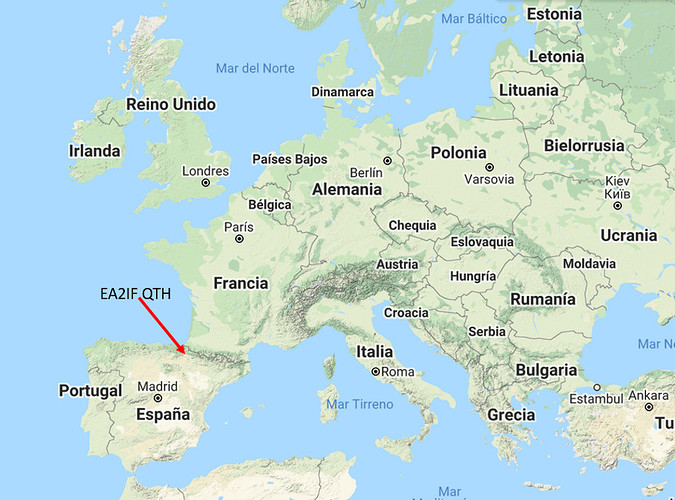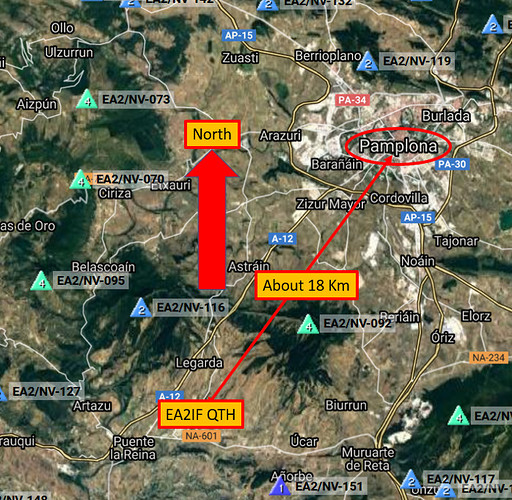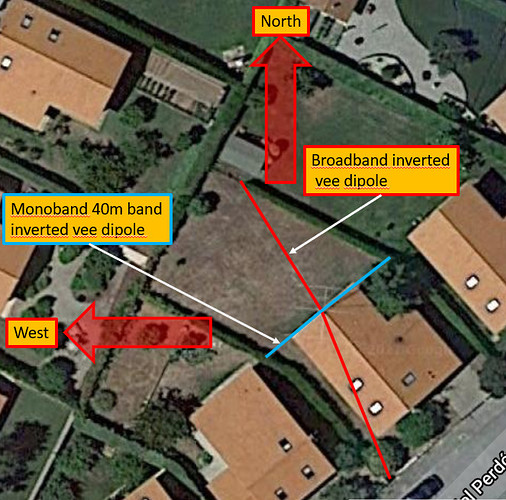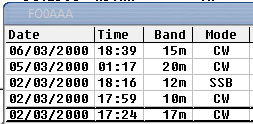Hi Andy,
Craig and I had our QSO on 20m at 08h50z and you showed up on 30m at 11h01z. A 2h10 time makes a huge difference and propagation conditions do change a lot in such a time window.
Not really. My location in Spain is very much North. I’m about 50Km in a straight line from the French border. However, my location in a Southerly peripheric Country makes it difficult for me to work central Europeans on 60m and 40m.
This is the location of my QTH with respect to the city of Pamplona:
30m is usually the best band for me to work central Europe.
Regarding the British and Irish, I find 30m OK, but I’d say 20m is slightly better for my actual antennas situation. Following you’ll see a satellite image of my QTH where I’ve drawn the dipole wires for you to see their orientation.
-
The broadband dipole in red, is multiband and I can use it on any band from 6m to 160m. Its orientation is NorthEast-SouthWest.
-
The monoband 40m bazooka dipole is much better than the broadband dipole on 40m and it’s the antenna I nearly always use on that band. Its orientation is NorthWest-SouthEast.
-
The yagi is a 5 elements tribander (4 el. on 10m, 3 el. on 15m and 3 el. on 20m). It’s beaming North in the image (taken many years ago) but it’s currently stuck beaming West:
I also have a monoband 80m bazooka dipole whose branches go pretty much together with the broadband dipole. I very rarely chase SOTA on 80m because central European or UK and EI activators are too far away for this band and there are very few activations in EA or F on 80m.
The yagi and the dipoles apex are about 14.5m above the ground.
As you can see on the above map, Central Europe (ON, DL, SP, HB, OE, OK, OM, HA, etc) are North-East of me, then I, S5, YU, 9A, YO, LZ, 4O, SV are all to the East, while the UK and Ireland are pure North. I often find that I can copy the UK and EI on 20m better with my yagi beaming West than with my broadband dipole oriented pretty much East-West.
My monoband 40m bazooka works fine for the UK on 40m too.
I have several options to try and its a lot of fun switching between different antennas to see the difference in reception between them. Sometimes, the broadband dipole gets and puts out a weaker signal but it gets less noise on RX than the monoband bazooka dipole and I have sometimes used the quieter broadband dipole for RX and the more punchy monoband bazooka for TX.
It’s difficult to say if one band is better than other for G-EA contacts. It all depends on propagation conditions and the time of the activations have a significant importance. The Eastern European countries often activate too early for us in the West of Europe and being the Sun on us 2-3 hours behind with respect to them, propagation conditions have not yet built up for us.
Well, sorry for my long post, but I hope you’ll find it of interest.
73,
Guru










